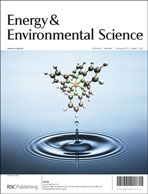Li–S batteries: simple approaches for superior performance†
Abstract
Although promising improvements have been made in the field of Li–S rechargeable batteries, they are still far from reaching the market place due to several drawbacks. To combat the solubility of polysulphides, confinement approaches aiming to trap sulphur within the cathode side have been pursued, but success has been limited. Herein, we drastically deviate from this approach and use a liquid cathode obtained either by dissolving polysulphides within the electrolyte or by placing sulphur powders in contact with the Li negative


 Please wait while we load your content...
Please wait while we load your content...